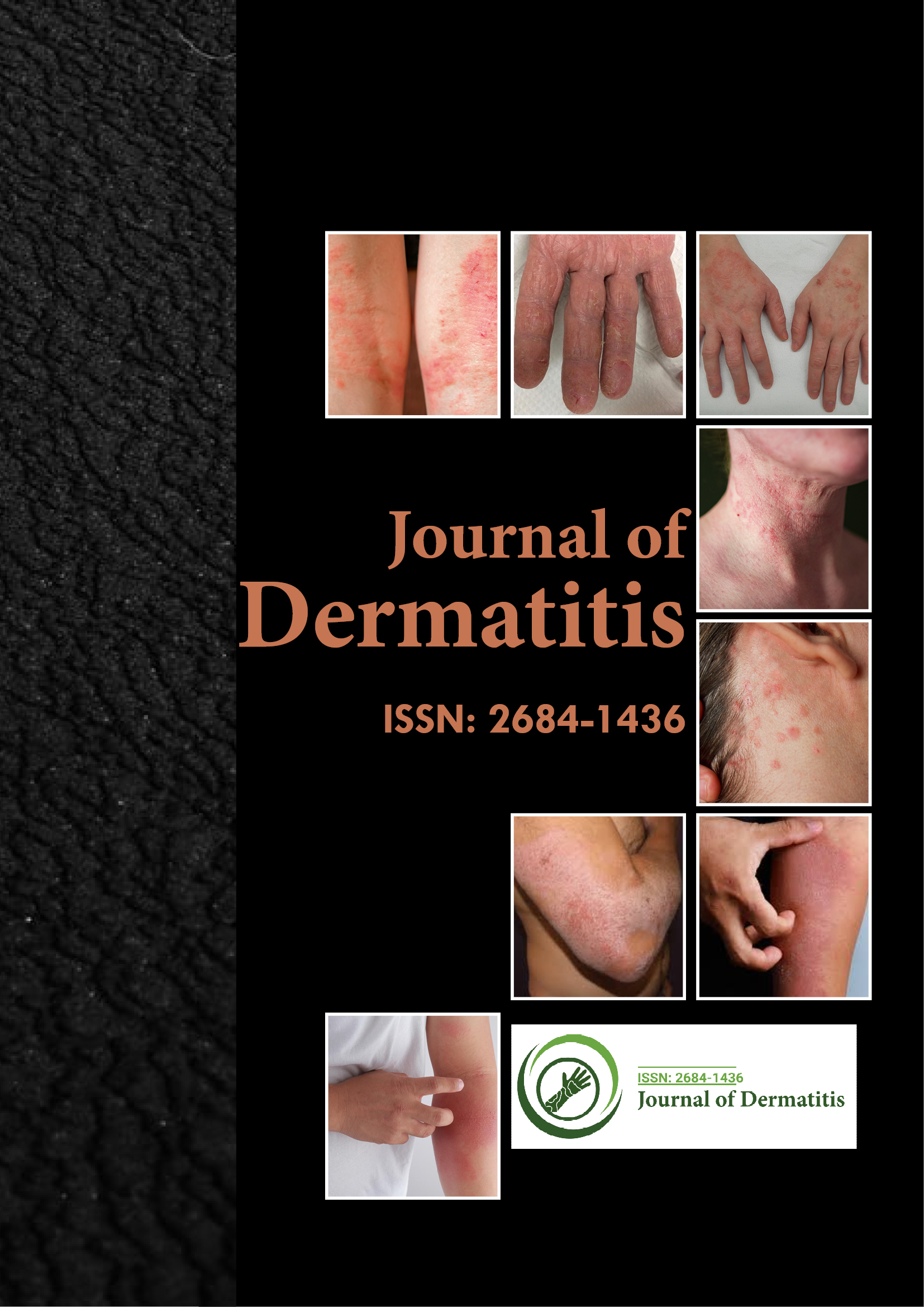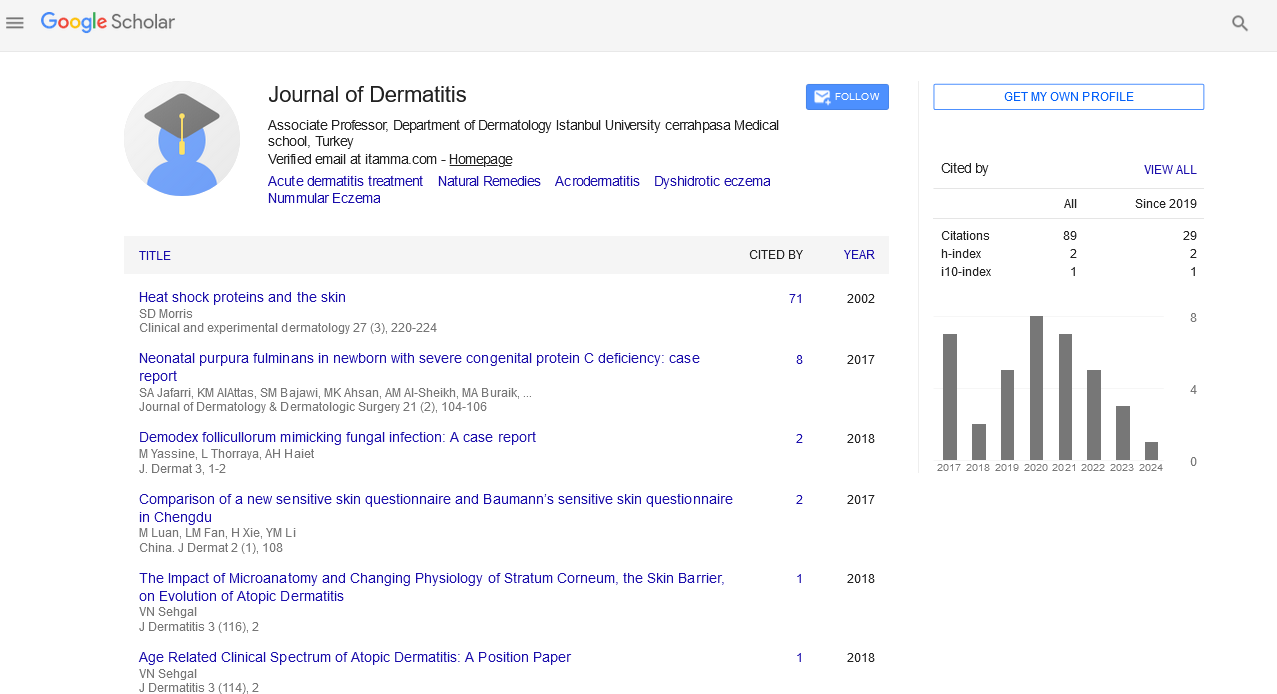Indexed In
- RefSeek
- Hamdard University
- EBSCO A-Z
- Euro Pub
- Google Scholar
Useful Links
Share This Page
Journal Flyer

Open Access Journals
- Agri and Aquaculture
- Biochemistry
- Bioinformatics & Systems Biology
- Business & Management
- Chemistry
- Clinical Sciences
- Engineering
- Food & Nutrition
- General Science
- Genetics & Molecular Biology
- Immunology & Microbiology
- Medical Sciences
- Neuroscience & Psychology
- Nursing & Health Care
- Pharmaceutical Sciences
Commentary - (2022) Volume 7, Issue 4
The Infectious Complications of Eczema
Fang-Yih Liaw*Received: 01-Jul-2022, Manuscript No. JOD-22-17654; Editor assigned: 04-Jul-2022, Pre QC No. JOD-22-17654(PQ); Reviewed: 18-Jul-2022, QC No. JOD-22-17654; Revised: 25-Jul-2022, Manuscript No. JOD-22-17654(R); Published: 01-Aug-2022, DOI: 10.35248/2684-1436.22.7.157
Description
Atopic dermatitis, also known as eczema, is a chronic skin condition that affects 15-20% of people worldwide, including those living in developed nations like the United States. It exhibits eczematous eruption, itching, and irritant sensitivity of the skin. For patients seen in pediatric dermatologists' offices, it is the most typical diagnosis [1].
Patients with eczema may experience secondary bacterial infections due to compromised protective skin function and changes in the quantity and quality of skin lipids. Most frequently, Staphylococcus aureus (SA) organisms are the etiologic agents. In actuality, staphylococcal organisms are present in up to 90% of eczema patients. The transition from colonization to infection is frequently accompanied by an eczema flare. Higher levels of colonization are related to increased eczema severity. When the infection first appears, there may be more erythema present; after that, the affected areas may crust over or experience severe drainage. The recent rise in Methicillin-Resistant Staphylococcus aureus (MRSA) makes it difficult to treat secondary eczema infections caused by these germs. The skin barrier should be repaired in patients with eczema and secondary bacterial skin infections using topical steroids or other anti-inflammatory drugs. By themselves, these medications reduce the amount of S. aureus colonisation on the skin. In more severe cases, it may be necessary to administer the proper topical or systemic antibiotics based on individual or group sensitivities [2].
Herpes Simplex Virus (HSV) cutaneous inoculation can happen as a result of the compromised protective skin function. Eczema that has been secondary infected with the Herpes Simplex Virus (HSV) is known as eczema herpeticum (also known as Herpes Simplex Virus-associated Kaposi varicelliform eruption) (either HSV type 1 or type 2). The eczema might become more erythematous, at which point vesicles form and take on a grouped pattern. Malaise, lymphadenopathy, and fever are additional symptoms. A Tzanck smear (looking for multinucleated giant cells), a fluorescent antibody smear, or culture of a vesicular lesion can all be used to make the diagnosis. The child might experience recurrences in the same regions that were initially affected. Acyclovir should be used to treat eczema herpeticum patients (the oral antiviral approved for use in patients less than 18 years of age). The use of systemic antivirals and hospitalisation may be necessary for more serious involvement. It is also advised to keep using topical steroids and moisturisers to repair the skin barrier [3-5].
Children with eczema tend to have more severe disease and more molluscum contagiosum infections. The lesions are described as smooth papules that can occasionally be umbilicated and appear on both affected and unaffected skin. Auto-inoculation to nearby areas can cause the lesions to spread. 10% of molluscum lesions are accompanied by molluscum dermatitis, which can be difficult to distinguish clinically from eczema lesions. Lesions caused by Molluscum contagiosum can sometimes heal on their own if left untreated. Alternative treatments for the lesions include curettage, liquid nitrogen, and cantharidin. Topical steroids are used to treat the molluscum dermatitis (the appropriate potency based on the location on the body) [6].
Live vaccinia virus is used to create the smallpox vaccine. When smallpox vaccinations were advised, who came into contact with the immunised adults. Patients with a history of eczema and those under the age of five are most likely to develop eczema vaccinatum, also known as Vaccinia-associated Kaposi varicelliform eruption. Even people without active eczema are at risk of dying. Eczema vaccinatum manifests as umbilicated pustules, papules, vesicles, or erosions that appear far from the inoculation site and have a preference for the locations of previous eczema lesions. Fever, malaise, and lymphadenopathy are common in patients. Clinical findings can be used to make a diagnosis. The Centers for Disease Control offers confirmation testing (CDC). Vaccinia immune globulin, hemodynamic support, wound care, and monitoring for superimposed infections make up the recommended course of treatment for eczema vaccinatum. Treatment with cidofovir has also been done.
For prompt application of the proper treatment, early detection of infections linked to an eczema diagnosis is essential.
REFERENCES
- Kurdi AT. Bullosis diabeticorum. The Lancet. 2013; 382:e31.
[Crossref], [Pubmed], [Google Scholar]
- Dinulos JG. Habif'Clinical Dermatology E-Book. Elsev Heal Sci. 2019.
[Crossref], [Pubmed], [Google Scholar]
- Jean B, Joseph LJ, Julie VS. Other Vesiculo bullous diseases. Dermatol. 2021.
[Crossref], [Google Scholar]
- Downing C, Tamirisa A, Khan F, Tyring S, Lapolla W. Bullosis diabeticorum: A rare bullous eruption in diabetes mellitus. J Am Acad Dermatol. 2014; 70:115.
[Crossref], [Pubmed], [Google Scholar]
- Parikh S, Murphy M, Chen A. A case of bullosis diabeticorum restricted to the fingers: 6756. J Am Acad Dermatol. 2018; 79:3.
[Crossref], [Google Scholar]
- Frioui M, Aouiche S, Ouerdane K, Boudiba A. P2131 << Bullose diabétique: A propos d’un cas>>. Diabetes Metab. 2013; 39:A99.
[Crossref], [Google Scholar]
Citation: Liaw FY (2022) The Infectious Complications of Eczema. J Dermatitis. 7:157.
Copyright: © 2022 Liaw FY. This is an open-access article distributed under the terms of the creative commons attribution license which permits unrestricted use, distribution and reproduction in any medium, provided the original author and source are credited.

